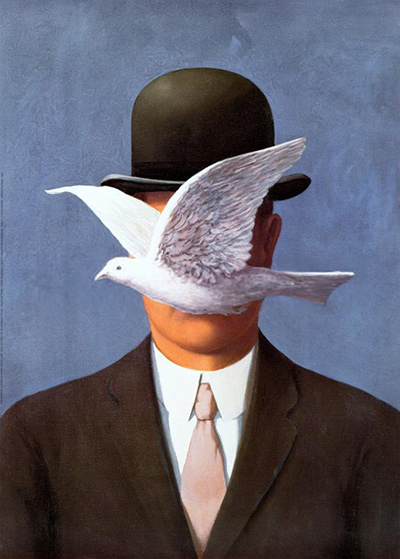Man in a Bowler Hat is a 1964 oil on canvas painting by Rene Magritte, who was a Belgian surrealist painter who lived from 1898 to 1967. As its name indicates, this painting deals with one of the themes that was most central in Magritte's career: that of the figure of a man in a bowler hat.
Man in a Bowler Hat depicts a man in a suit and a bowler hat with a dove obscuring his face. It is important to note that in the same year, Magritte painted another very similar painting, which also depicted a man in a suit and a bowler hat, but this time the man's face is obscured by an apple. This painting is perhaps the most iconic of all of Magritte's works, and it is called 'Son of Man'. Why was Magritte so interested in the figure of the bowler hatted man? There are several theories about this issue. One compelling idea is that the man in the bowler hat is in fact Magritte himself. This is borne out by photographic evidence which demonstrates that very often, Magritte did favour the 'uniform' of a black suit and black bowler hat. Another theory has to do with the genre of the paintings: surrealism. Sigmund Freud, a huge influence on surrealist painters such as Magritte and Salvador Dali, stated that The Uncanny consisted in everyday objects made strange and unfamiliar.
The same can be said of surrealism, and especially of Magritte's own brand of surrealism. Throughout his career, Magritte particularly loved to paint everyday objects such as fruit or plain tables but to make them strange and dreamlike by placing them out of context. In Son of Man, as already mentioned, an apple hovers in front of a bowler hatted man's face. And in a slightly earlier work, Oasis, a plain table is placed in the desert, and lush green trees sprout from it. Perhaps, then, Magritte loved the image of the man in a bowler hat because there is something inherently surreal about it: it is familiar and everyday but it is also strange because it becomes a kind of impersonal, even dehumanising, uniform.
Another notable aspect of Man in a Bowler Hat is the fact that the central figure's face is obscured. Figures with their faces obscured are a key theme in Magritte's artistic oeuvre. As we have already seen, 'Son of Man' depicts a man with his face hidden by an apple, whilst another painting, 'The Lovers' shows two people kissing, their heads both totally covered by cloth sacks. Critics have speculated that Magritte's fascination with the hidden or covered face stems from a very traumatic event in his childhood. When he was just 14, his mother drowned, and he related that he was shocked to see that when her body was taken from the river, her face was covered with a cloth so that he could not see it.
In sum, then, Man in a Bowler Hat is a fascinating painting, executed whilst Magritte was at the height of his powers. It is highly related to his other works of art, and though it may seem to be a very dreamlike painting it is potentially rich in biographical detail. Man in a Bowler Hat is a work of art that evokes the conventions of traditional portraiture only to subvert them and to play with them. Whilst a classic portrait in oils might be executed with the aim of revealing something about the sitter, Man in a Bowler Hat obscures the sitter from view, despite placing him right in the foreground of our vision. Or perhaps we can say that Man in a Bowler Hat, after some careful decoding, actually reveals a lot of information not about the sitter but about the artist himself. Perhaps, indeed, they are one and the same.




